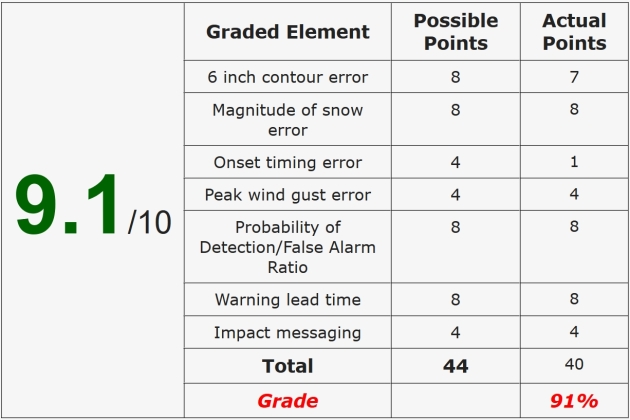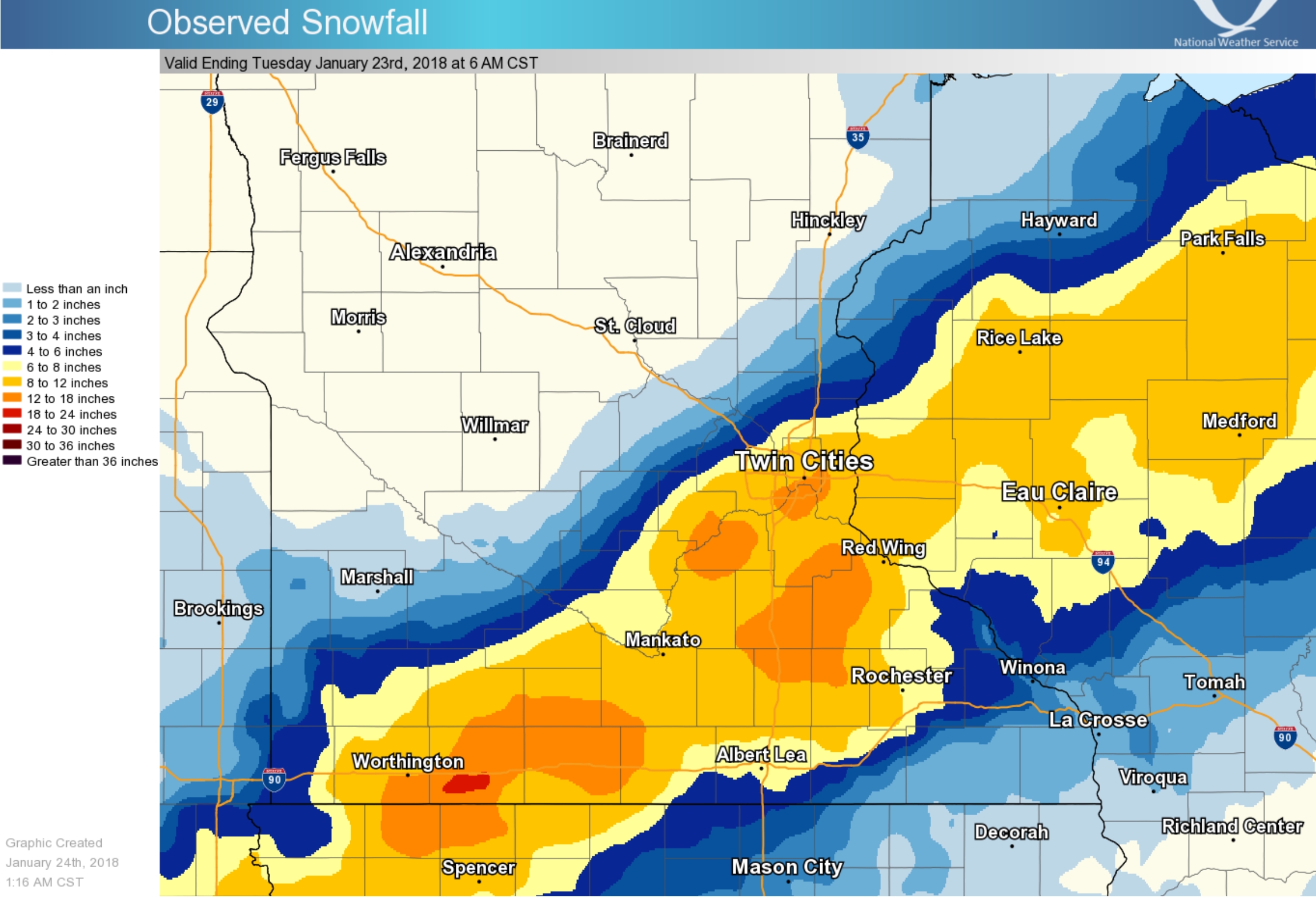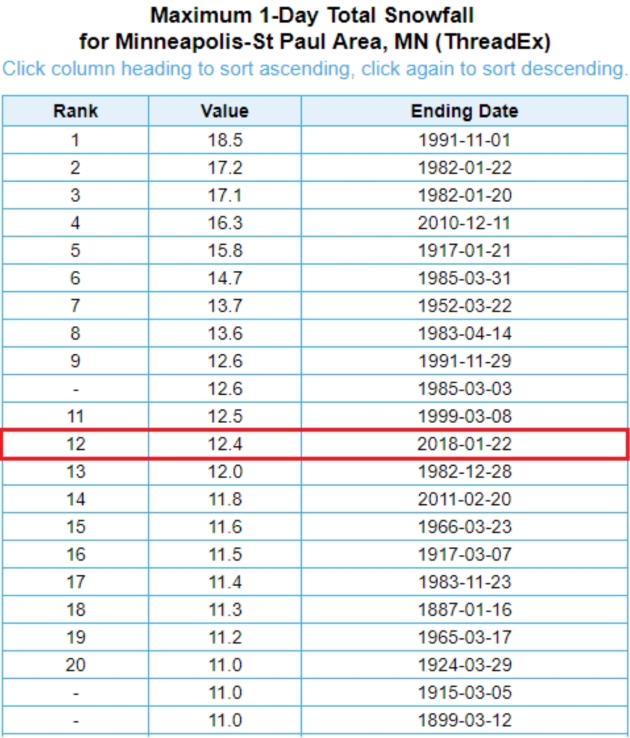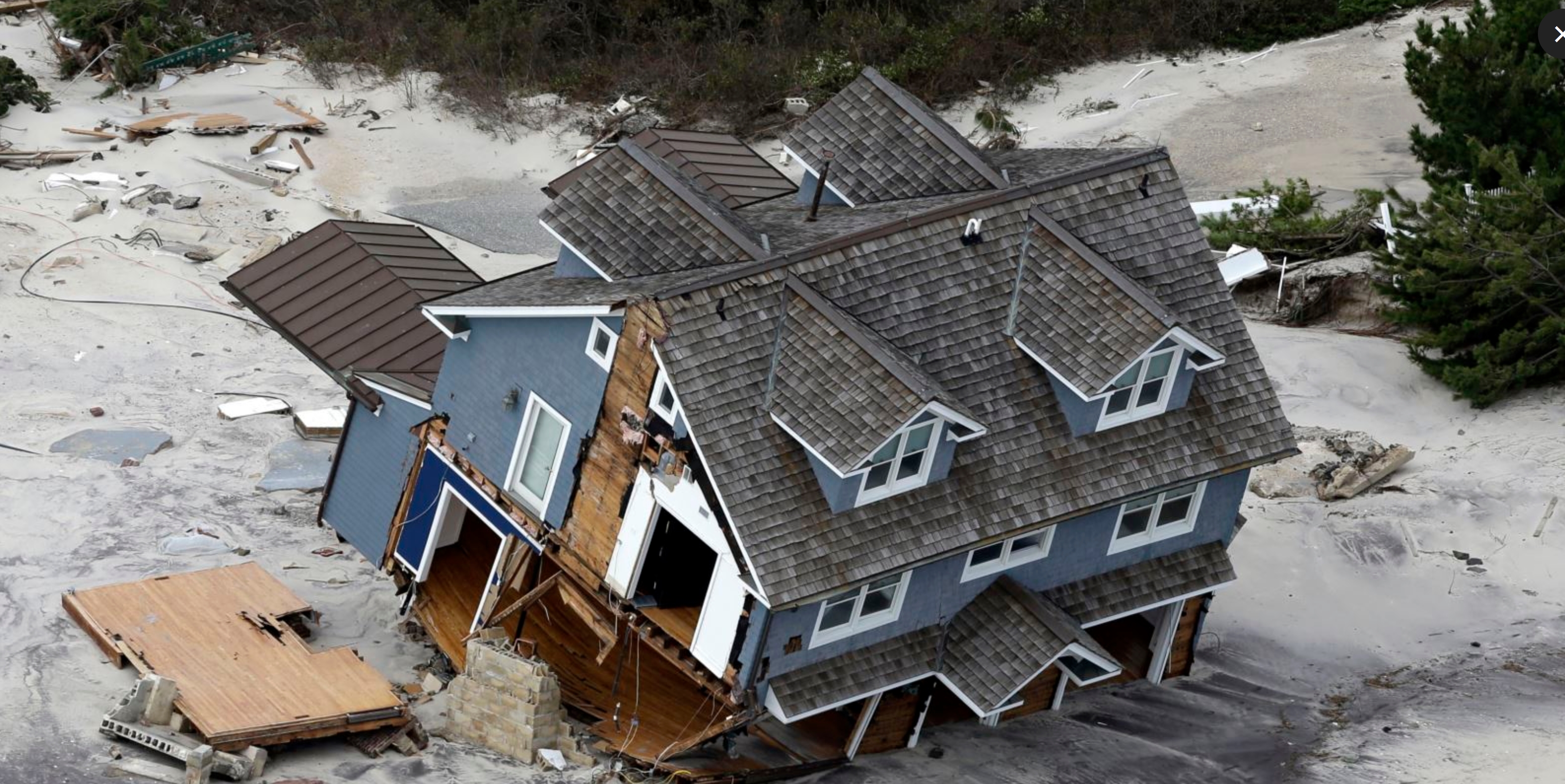Enjoy The Thaw – Looks Like a Nanook Super Bowl
Every season has it’s own unique meteorological challenges. Unlike hit-or-miss summer storms, precipitation during the winter months is generally widespread; everybody sees snow. As Monday’s storm pointed out, the big question is how much snow, and when will the worst travel conditions arrive?
Predicting high temperatures can be tricky when warmer fronts approach in January. If the sun is out that’s one thing, but relatively mild, moist air from the Gulf of Mexico passing over fresh snow cover can cool the air from below, sparking lazy clouds – fog – capable of keeping temperatures 10-15F. cooler.
It’s always something.
If fog lifts we may hit 40F today in the metro area before cooling down over the weekend; another brief thaw possible the middle of next week.
Model guidance hints at a coating of snow next Saturday, followed by a chilly Super Bowl Sunday, with single digit highs and a wind chill dipping below zero. Welcome Patriots and Eagles fans! When we say CHILL, we really mean it.
The first week of February brings more subzero lows, but it warms up again by mid-month.
Hot or Not: History Shows Super Bowl Game Day Weather in Minnesota Can Swing Wildly. Plan on signifiicantly colder than average on Feb 3-4 and be pleasantly surprised if the cold air doesn’t materialize. Here’s an excerpt from
Star Tribune: “…
The Minnesota Super Bowl Host Committee’s on-the-record hope has been temperatures in the high 20s with a dusting of fresh, white snow wafting from the heavens, a Minnesota-nice stretch of winter that is cold enough to keep ice sculptures from sweating, warm enough to keep visitors party-hopping and out of the hospital emergency rooms. Committee logistics gurus have made multiple weather contingency plans that include a 36-inch snowfall. Let’s not kid ourselves, however. We’re bold and bad, but we’re just coming off a 12-inch snowfall in the Twin Cities that stretched coping skills…”

Forecast Assessment of the January 22, 2018 Snowstorm. I agree with the grade – the National Weather Service did a good job with this storm, so did local meteorologists. There are (many) times we deserve withering criticism for blowing the forecast, but this was not one of those times. Here’s an excerpt from
NOAA: “
This storm was forecasted well overall. Models were consistent for almost a week with developing a major winter storm over the central Plains and tracking it east northeast to the Great Lakes. The forecast called for significant snowfall accumulations across southern and portions of eastern Minnesota and western Wisconsin for several days leading up to the event. It was clear there would be a sharp snowfall gradient. What made the forecast difficult was determining where it would set up. Slight run to run differences in modelling resulted in the gradient shifting north and south of the Twin Cities metro area. This decreased forecasters’ confidence in its placement and prevented a depiction of a more realistic snowfall gradient in forecast graphics. However, it was stressed repeatedly through social media and official forecast products the placement of the gradient was the highest forecast uncertainty, and that drastic changes to the forecast may occur on local scales if it shifted one way or the other. Winter Storm Watches remained posted for the area near the gradient, while Winter Storm Warnings and Blizzard Warnings were issued earlier for the heart of the snow band. This messaging was well received by our customers. The storm moved in a bit slower than expected and a few points were deducted for timing…”



12th Biggest One-Day Snowfall Since 1875. That’s according to NOAA and the Minnesota Climate Office.
Biggest Snowfall Since February 21, 2011. If you look at 2-day storm totals, the 12.4″ that fell at MSP International Airport Monday was the most since 13.8″ fell over 2 days in late February, 2011.
Slow Moderation Second Week of February. There’s every indication February will start on a cold note, perhaps 10-15F. colder than average, but GFS guidance hints at more of a Pacific flow returning for the second week of February. With a rapidly rising sun angle it can’t stay as cold – as long – in February as it can in January.

School Dilemma: When to Call a Snow Day? It’s a complicated matrix of factors, which varies from school district to district. Here’s an excerpt from
Star Tribune: “…
Superintendents base their calls mainly on two factors: the safety of students and the ability of school buses to navigate roads. But weather forecasts can be wrong, placing school leaders in a tough spot. Should they decide to cancel classes based on an erroneous forecast, they run the risk of unnecessarily disrupting children’s learning and parents’ schedules. If they stay open, as St. Paul and Minneapolis did on Monday, they run the risk of a fiasco. On rare occasions, the state’s governor has stepped in to declare a statewide snow day...”
National Hurricane Center Tropical Cyclone Report on Hurricane Harvey. There’s some information in this 76-page PDF I haven’t seen before,
courtesy of NOAA.
Paris Braced For More Flooding as Seine Keeps Rising. Here’s an excerpt of an update from France 24: “The Seine is expected to reach a peak of up to 6.2 metres (20.3 feet) in the capital this Saturday on a scale used to measure its levels, four to five metres above its normal height. The December-January period is now the third-wettest on record since data started being collected in 1900, according to the national weather service, Meteo France. Many regions have seen double the rainfall than normal, including Paris where 183 millimetres (7.2 inches) have been dumped since December 1. More rain was forecast for Thursday…”

Earthquake Fault Runs Through Rodeo Drive in Beverly Hills, California Geologists Say. Here’s an excerpt from a story at
The L.A. Times: “…
Prehistoric earthquakes threw up the north side of Santa Monica Boulevard, Dawson said, forming the dramatic hillside perch that the Mormon temple now calls home and moving it west toward the ocean. The area to the south of the boulevard is getting relatively lower and has also been shifting to the east. California law prohibits new development on top of fault lines, but it does not require existing buildings in the zones to be altered. State scientists have various degrees of certainty about the fault’s location. Some drawn paths are considered accurate based on detailed geology investigations on specific plots of land to identify a fault. Other sections of the fault are considered approximately located...”
Map credit: California Geological Survey, Mapzen, OpenStreetMap Raoul Ranoa/@latimesgraphics.

Killer Air. 92% of people globally live in places with dangerous levels of air pollution.
Huffington Post has the story: “
Every year, millions of people die as a result of air pollution-related illnesses. According to the World Health Organization, 11.6 percent of all deaths worldwide are associated with air pollution, making it almost as deadly as tobacco. Watery eyes, wheezing and difficulty breathing are acute and common reactions. But air pollution has other, less perceptible but insidious effects — and it can harm you even before you take your first breath. Exposure to high levels of air pollution during pregnancy has been linked to miscarriages and premature births, as well as autism spectrum disorder and asthma in children. In a comprehensive study of the effects of air pollution in the United States, scientists at Harvard University found air pollution is especially dangerous for men, the poor and African-Americans, who are about three times as likely to die from exposure to the tiny pollutants...”

U.S., a Fossil Fuel Leader, Getting Outflanked on Advanced Energy. Will America lead the next inevitable energy revolution? Here’s a clip from
Axios: “..
.Saudi Arabia, for example, intends to invest $7 billion in renewable projects this year, while a Saudi industrial group is already developing 5 gigawatts of renewable projects globally, with a major focus on Latin America. Another Saudi-Chinese consortium is investing significant sums in Egypt’s nascent renewable energy sector. China is set to account for more than half of global solar deployment and electric vehicle sales this year. Beijing’s “Belt and Road” initiative will accelerate the Middle Kingdom’s plans to become a clean energy powerhouse, and China is also poised to construct a network of high-voltage power lines across the Eurasian landmass. Add to this the fact that the U.S. will soon fall behind China in overall R&D spending, and the picture of an energy-rich, yet complacent, America emerges...”
File image: MN.gov.
Can Planet Earth Feed 10 Billion People? Here’s a clip from a sobering story at
The Atlantic: “…
Were the Prophets disproved? Was carrying capacity a chimera? No. As Vogt had predicted, the enormous jump in productivity led to enormous environmental damage: drained aquifers, fertilizer runoff, aquatic dead zones, and degraded and waterlogged soils. Worse in a human sense, the rapid increase in productivity made rural land more valuable. Suddenly it was worth stealing—and rural elites in many places did just that, throwing poor farmers off their land. The Prophets argued that the Green Revolution would merely postpone the hunger crisis; it was a one-time lucky break, rather than a permanent solution. And our rising numbers and wealth mean that, just as the Prophets said, our harvests will have to jump again—a second Green Revolution, the Wizards add…”

World’s First Electric Container Barges to Sail from European Ports This Summer. The Guardian has details: “
The world’s first fully electric, emission-free and potentially crewless container barges are to operate from the ports of Antwerp, Amsterdam, and Rotterdam from this summer. The vessels, designed to fit beneath bridges as they transport their goods around the inland waterways of Belgium and the Netherlands, are expected to vastly reduce the use of diesel-powered trucks for moving freight. Dubbed the “Tesla of the canals”, their electric motors will be driven by 20-foot batteries, charged on shore by the carbon-free energy provider Eneco…”
Image credit: “Dutch manufacturer, Port Liner, has developed the world’s first emission-free barges.” Photograph: Courtesy of The Loadstar.
SOLAR TARIFFS: From Climate Nexus: “
Trump offers consolation prize to solar industry after tariffs (Bloomberg, AP, Washington Examiner, The Hill), LA’s booming solar installation business may suffer under Trump tariff (CBS LA), Trump’s solar tariffs to cause some demand destruction (Bloomberg), one US solar maker wants to be excluded from Trump’s tariffs (Bloomberg), job creator, or job killer? Trump angers solar installers with panel tariff (Reuters), while it could have been worse, solar tariffs may hit Trump country hard.” (
InsideClimate News).
Map credit: Climate Central.
The Biggest Career Mistake is Getting Too Comfortable. Innovate, reinvent, or fade away – the cycles of change and disruption are coming faster now; all of us have to wrap our heads around a career of lifelong learning. Here’s a clip from
Quartz: “…
So what did I learn after several reinventions over more than three decades? Growth and comfort don’t co-exist. Neither do change and comfort. It would have been easy for me to stay a watchmaker or work on displays for 35 years, but I have zero regrets for having seized other opportunities to change and reinvent myself. Whether it’s a change in technology or a strategy, which pushes you in a new direction, embrace or even accelerate it, don’t fight it. The biggest mistake is to get too comfortable. If you find yourself to be the expert with the most experience in your field, you might already have missed several valuable opportunities for re-invention...”

Botoxed camels aren’t welcome in Saudi Arabia. Reuters explains: “…A dozen beasts have been disqualified from this year’s Saudi “camel beauty contest” because their handlers used Botox to make them more handsome. “The camel,” explained the chief judge of the show, Fawzan al-Madi, “is a symbol of Saudi Arabia. We used to preserve it out of necessity, now we preserve it as a pastime.” Much is changing in Saudi Arabia: the country is getting its first movie theaters. Soon women will be permitted to drive. The authorities eventually hope to diversify the economy away from the oil that has been its lifeblood for decades…”
Photo credit: “Saudi men stand next to camels as they participate in King Abdulaziz Camel Festival in Rimah Governorate, north-east of Riyadh, Saudi Arabia January 19, 2018. Picture taken January 19, 2018.” REUTERS/Faisal Al Nasser.


26 F. maximum temperature yesterday in the Twin Cities.
24 F. average high on January 25.
32 F. high on January 25, 2017.
January 26, 1916: A severe ice storm hits Mower County. Hundreds of birds were killed.


FRIDAY: Sunny peeks, a milder day. Winds: SW 10-15. High: 41
FRIDAY NIGHT: Patchy clouds. Low: 27
SATURDAY: Mostly cloudy and cooler. Winds: W 10-15. High: 36
SUNDAY: Partly sunny and brisk. Winds: NW 8-13. Wake-up: 12. High: 19
MONDAY: Bright sunshine, light winds. Winds: NW 3-8. Wake-up: 3. High: 15
TUESDAY: Mostly cloudy, winds increase. Winds: SE 10-20. Wake-up: 6. High: 24
WEDNESDAY: Chance of light snow or flurries. Winds: NW 10-15. Wake-up: 21. High: 33
THURSDAY: February starts out chilly with some sun. Wake-up: 6. High: 12
Climate Stories…
How to Save a Town From Rising Waters. Coastal Louisiana has some of America’s first climate change refugees. Rising water is forcing some people off their land, as described by CityLab: “…Isle de Jean Charles, home to the Biloxi-Chitimacha-Choctaw band of Native Americans, has lost 98 percent of its land since 1955. Its 99 remaining residents have been dubbed “America’s first climate refugees.” “There’s just a little strip of it left,” said resident Rita Falgout. “There used to be a lot of trees; we didn’t have so much salt water.” Like many of the houses on Isle de Jean Charles, her home is raised on 15-foot stilts to evade the increasingly omnipresent floodwaters. But the stilts can’t protect her from the island’s isolation. Strong winds alone can flood the road, cutting the island off from vital resources like hospitals. Soon the road will be impassable year-round…”
Photo credit: “Island Road frequently floods, cutting off Isle de Jean Charles from the mainland.” (Michael Isaac Stein).

The Global CO2 Rise: the Facts, Exxon, and Favorite Denial Tricks. Here’s an excerpt of a post at Real Climate: “The basic facts about the global increase of CO2 in our atmosphere are clear and established beyond reasonable doubt. Nevertheless, I’ve recently seen some of the old myths peddled by “climate skeptics” pop up again. Are the forests responsible for the CO2 increase? Or volcanoes? Or perhaps the oceans? Let’s start with a brief overview of the most important data and facts about the increase in the carbon dioxide concentration in the atmosphere:
- Since the beginning of industrialization, the CO2 concentration has risen from 280 ppm (the value of the previous millennia of the Holocene) to now 405 ppm.
- This increase by 45 percent (or 125 ppm) is completely caused by humans.
- The CO2 concentration is thus now already higher than it has been for several million years.
- The additional 125 ppm CO2 have a heating effect of 2 watts per square meter of earth surface, due to the well-known greenhouse effect – enough to raise the global temperature by around 1 °C until the present…”
Image credit: “Perhaps the most important scientific measurement series of the 20th century: the CO2 concentration of the atmosphere, measured on Mauna Loa in Hawaii. Other stations of the global CO2 measurement network show almost exactly the same; the most important regional variation is the greatly subdued seasonal cycle at stations in the southern hemisphere. This seasonal variation is mainly due to the “inhaling and exhaling” of the forests over the year on the land masses of the northern hemisphere.” Source (updated daily): Scripps Institution of Oceanography.

Farmland Could Be Used to Sustainably Offset America’s Entire Carbon Footprint – If the Will Exists. Quartz explains: “…One solution stands out. Eighty-nine percent of agriculture’s future mitigation potential could lie in capturing carbon on farmland soils: carbon sequestration. Not only does this process suck harmful carbon out of the atmosphere, it makes soils healthier and more fertile for future food production, boosting resilience to climate change. Soil carbon sequestration should make both sides of the mitigation vs. adaptation debate happy. Efforts to capitalize on this win-win solution need to be stepped up—and now. To do this, we needed to determine which areas in the world could contribute which quantities of carbon sequestration. A new paper published in Scientific Reports tells us just that…”
File image: iStock.

Survey: U.S. Mayors View Climate Change as Pressing Urban Issue. Here’s an excerpt from VOA, Voice of America: “…U.S. mayors increasingly view climate change as a pressing urban issue, so much so that many advocate policies that could inconvenience residents or even hurt their cities financially. The annual survey of big-city executives, released Tuesday by the Boston University Initiative on Cities, also reflected the nation’s sharp political divide. Ninety-five percent of Democratic mayors who responded believed climate change was caused by human activities, a view shared by only half of Republican mayors. A clear majority of mayors were prepared to confront President Donald Trump’s administration over climate change and felt their cities could be influential in counteracting the policies of the Republican president, who at times has called global warming a hoax and last year withdrew the U.S. from the Paris climate accord…”
Photo credit: “This Oct. 31, 2012 file aerial photo shows a collapsed house along the Jersey Shore coast. A recent poll shows that a clear majority of mayors are prepared to confront President Donald Trump’s administration over climate change.”

Carbon Fees and the Mystery of the Untaxed Negative Externality. Now there’s a mouthful. CleanTechnica explains: “…De-carbonizing the environment is going to be expensive. Mitigating the harm that has already occurred and reducing the damage fossil fuels will do in the future will cost trillions and trillions of dollars. Everybody wants to do something about carbon emissions (except Scott Pruitt, of course) but nobody wants to pay for it. Asking people if they want to pay a tax to help out is like asking if they would like a colonoscopy. Addressing climate change is vitally important as the world approaches its existential moment. Environmentalists must stop shooting themselves in the foot by calling their plans “taxes.” It’s not always about what you say. More often than not, it’s about how you say it. The city of New York is now asking the courts to make ExxonMobil pay for the damage it has caused and will continue to cause. That could be a very effective way of taxing the negative externalities the fossil fuel industry has enjoyed for almost a hundred years...”
File image: Star Tribune.

How Engineering Earth’s Climate Could Seriously Imperil Life. WIRED.com has the article; here’s an excerpt: “…A study out today in Nature Ecology & Evolution models what might happen if humans were to geoengineer the planet and then suddenly stop. The sudden spike in global temperature would send ecosystems into chaos, killing off species in droves. Not that we shouldn’t tackle climate change. It’s just that among the many theoretical problems with geoengineering, we can now add its potential to rip ecosystems to shreds. The models in this study presented a scenario in which geoengineers add 5 million tons of sulfur dioxide to the stratosphere, every year, for 50 years. (A half century because it’s long enough to run a good climate simulation, but not too long that it’s computationally unwieldy. The group is planning another study that will look at 100 years of geoengineering.) Then, in this hypothetical scenario, the sulfur seeding just stops altogether—think if someone hacks or physically attacks the system…”
File image: NASA.





